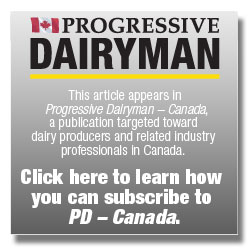Each individual piece of the silage management puzzle plays a significant role in the outcome of the overall feed quality for the dairy herd. From crop variety selection, to packing, to bunker and drive-over pile covering materials, each step has its own set of options and challenges.
Bob Matzek, a registered Holstein producer located in the Fraser Valley in British Columbia, pays careful attention to detail when it comes to the variables of silage production he can control.
Communication and packing
“Making silage can be unpredictable, especially when it comes to weather. By controlling when we harvest, how we pack and properly covering the silage, we can take parts of the process into our own hands.
On our operation we make sure everyone is on the same page before any crop comes out of the field as to how we’re going to handle packing and covering.
Communication is so important when it comes to putting up feed,” Matzek stresses.
Matzek is the owner and feed manager at Westar Holsteins, which is home to around 70 purebred dairy cows.
As part of the feed management program, the operation hires a custom harvester to come in and harvest the 40 acres of land planted with corn for corn silage.
Before harvesting, Matzek meets with his harvester to go over exactly how and when the corn will be harvested and packed.
Communication is vital for a successful feed management program, whether working with a custom harvester or your own employees.
Setting expectations and communicating the plan of action for efficient harvesting and storing with employees in advance will keep things moving along efficiently.
“We set expectations beforehand, and I make sure our custom harvester doesn’t bring in the corn too fast.
We need to make sure it’s packed properly. Our goal is to spread it out so we never pack more than six inches at a time, so we have a good pack,” Matzek notes.
Packing is a vital step when it comes to preserving silage, and careful attention to detail is needed.
According to the Kansas State University silage team, packing at 16 pounds of dry matter per cubic foot is the target packing density to minimize shrinkage loss.
After packing, timely covering of the bunker silos or piles is necessary for efficient fermentation and to protect silage at the surface from the detrimental effects of oxygen.
“The big thing is packing – pack slowly and don’t bring in too much silage at once. Once the silage is packed, you want to make sure it’s sealed and sealed quickly,” Matzek says.
Protection and covering
Another piece of silage preservation that producers can control is the selection and application of covering plastic.
Silage covering should block oxygen from entering the pile or bunker, provide an environment for fermentation and maintain feed quality by protecting the initial inputs.
Surface spoilage and visible dry matter loss are just two indicators the covering may not be doing its job.
For the last three years, after packing in the corn, Matzek has been covering the operation’s concrete bunkers with a two-step system.
First, a layer of clear oxygen-barrier plastic is applied that clings to the crop. The film is then followed by a layer of tarp.
Finally, gravel sandbags are applied to finish sealing the bunkers. Matzek says he chose the two-step system because it’s an added barrier between his feed investment and oxygen, which can spoil feed and decrease quality.
“With the two-step system we don’t have to worry about the top layer being spoiled when we go to feed it out. It also saves us time and labour when it comes to pitching silage,” Matzek says.
Year-round evaluation of silage quality during feedout, including silage testing and visible quality checks, provides insights into covering performance.
Summary
Harvesting is just around the corner, and now is a perfect opportunity to plan ahead and prepare for storing this year’s silage crop.
Set up meetings now with employees and custom harvesters to discuss what worked or didn’t work during last year’s harvest.
These meetings are also a good time to set expectations, divide harvest time responsibilities and establish timelines. Work together as a team, but realize that each person will bring different insights and ideas for areas of improvement.
Finally, as covering purchases and orders are being placed, be sure to evaluate how your current products are performing.
Not all plastic covering materials are made equal. Shopping around, talking with other producers and doing research on a product upfront can create significant returns through the protection of your feed investment in the end. PD
PHOTO: Bob Matzek, a registered Holstein producer located in the Fraser Valley in British Columbia, implements a two-step system to cover his tightly packed silage. Photo courtesy of Silostop .

-
Deanna Hiemstra
- Dairy Forage Specialist - Canada Silostop
- Email Deanna Hiemstra










